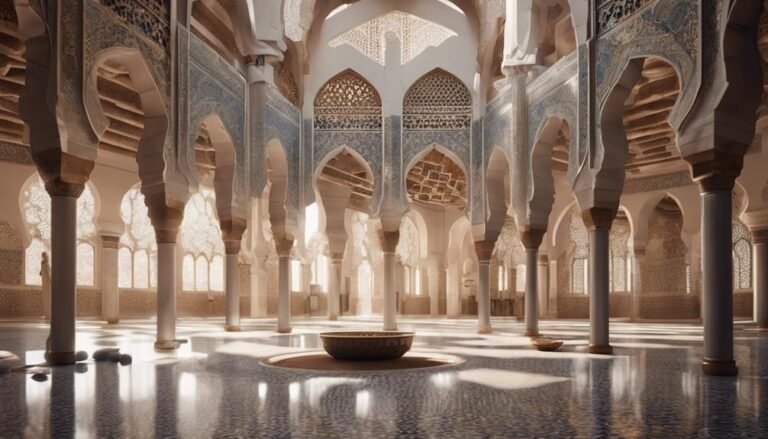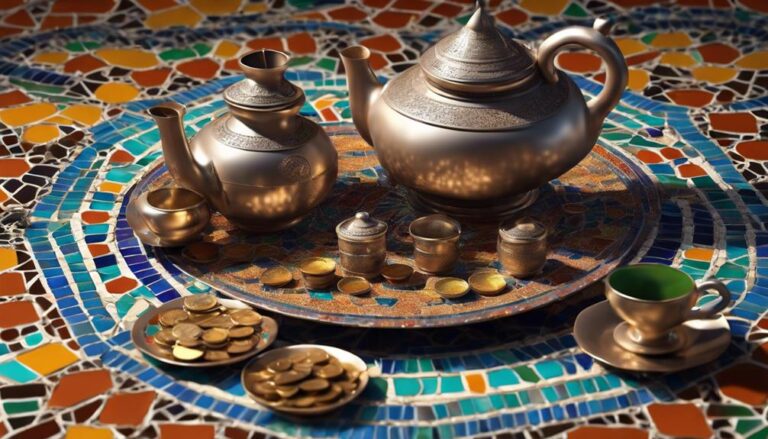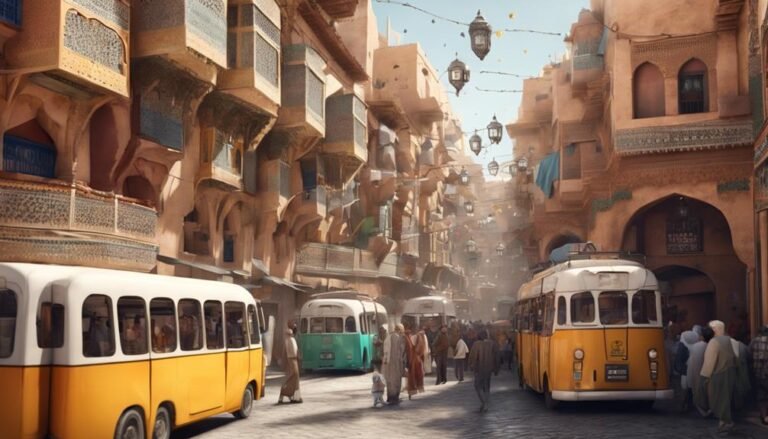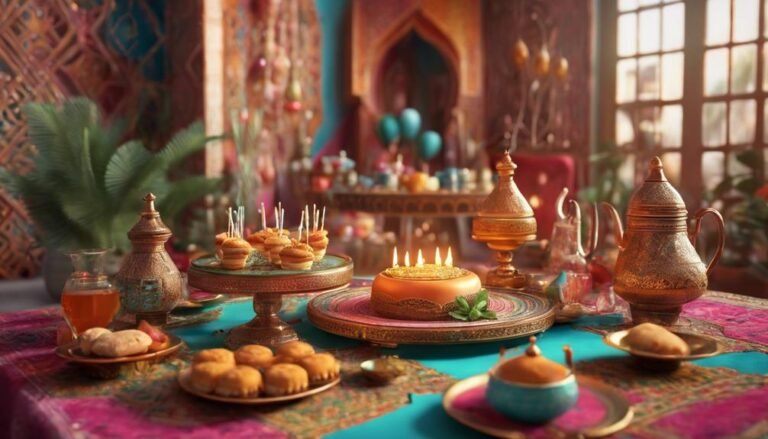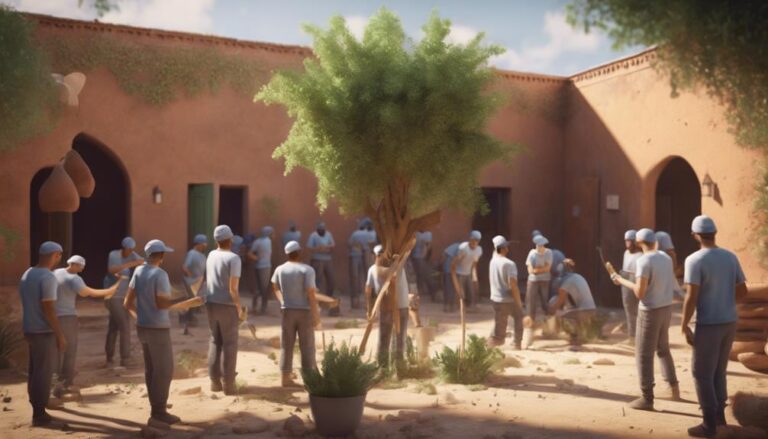Step into the world of Moroccan architecture, where a blend of Berber, Arab, and Andalusian influences weaves a tapestry of earthy tones, intricate geometric patterns, and vibrant colors. Experience the beauty of arched doorways, decorative tilework, and ornate carvings that adorn courtyards with tranquil fountains. Moroccan architecture reflects centuries of cultural history, showcasing exquisite craftsmanship and artistic expression. Symbolic meanings, fusion of styles, and attention to detail create a mesmerizing experience. Discover the complexity and beauty of this architectural tradition, a true reflection of Morocco's diverse heritage and rich artistic legacy. Uncover the secrets behind this enchanting architectural world.
Key Takeaways
- Moroccan architecture features intricate geometric patterns and vibrant colors.
- Arabesque designs, decorative tilework, and carved woodwork are prominent elements.
- Courtyards with fountains offer peaceful retreats in Moroccan architecture.
- The fusion of Berber, Arab, and Andalusian styles creates a unique and rich architectural heritage.
- Moroccan architecture reflects diverse cultural influences and influences global design trends.
Influences From Various Cultures
Incorporating elements from Berber, Arab, and Andalusian traditions, Moroccan architecture showcases a rich tapestry of cultural influences that have shaped its distinctive style. The cultural fusion in Moroccan architecture is a result of centuries of artistic influences from various civilizations that have inhabited the region. Berber tribes introduced the use of earthy tones and organic materials, while Arab architectural styles brought intricate geometric patterns and ornate calligraphy. Andalusian influences can be seen in the intricate tile work and decorative arches that adorn many structures.
Cross-cultural craftsmanship is evident in the meticulous attention to detail and the blending of different architectural techniques. The historical context of Moroccan architecture reflects a diverse heritage that has been shaped by trade routes, conquests, and artistic exchanges. From the intricate zellige tile mosaics to the towering minarets of mosques, each element in Moroccan architecture tells a story of cultural exchange and artistic innovation. The fusion of these diverse influences has created a unique architectural style that's both visually stunning and historically significant.
Geometric Patterns in Islamic Design
Geometric patterns play a pivotal role in Islamic design, serving as a fundamental element that embodies mathematical precision and symbolic significance. In Islamic art, these intricate patterns aren't merely decorative but hold deep cultural and religious meanings. The geometric complexity seen in Moroccan architecture reflects the Islamic principle of unity and order in the universe. By utilizing shapes like circles, squares, and stars, artisans create mesmerizing designs that symbolize infinity, harmony, and the interconnectedness of all creation.
Islamic art's focus on geometric patterns stems from the belief that these designs reflect the underlying order of the cosmos, echoing the perfection of a higher power. The repetition of geometric motifs in architecture serves to immerse the viewer in a meditative state, encouraging contemplation of the divine. The intricate interplay of lines and shapes in Islamic geometric art showcases the mastery of craftsmen in transforming simple forms into mesmerizing visual symphonies that captivate the eye and nourish the soul.
Colorful Tiles and Ornate Carvings
Colorful tiles and ornate carvings are distinctive features in Moroccan architecture, adding vibrant hues and intricate details to the structures. Intricate mosaics, known as zellige, are a hallmark of Moroccan design. These mosaics consist of geometric patterns formed by colorful tiles meticulously cut and assembled to create mesmerizing compositions. The process of creating zellige involves skilled artisans who chip and shape each tile by hand before arranging them into intricate designs that adorn walls, floors, and ceilings.
In addition to the detailed mosaics, Moroccan architecture is renowned for its elaborate carvings. The intricate carvings, often found on wooden doors, ceilings, and plasterwork, showcase a rich tradition of craftsmanship. These carvings feature geometric motifs, floral patterns, and calligraphic inscriptions that reflect the cultural influences and historical significance of the region. The ornate carvings not only serve a decorative purpose but also convey symbolic meanings, telling stories of the past and adding layers of complexity to the architectural masterpieces of Morocco.
Reflection of Rich History
You'll notice in Moroccan architecture a tapestry woven with historical influence, each building telling a story of the past.
The intricate designs aren't just decorative; they carry a deep cultural significance, reflecting the diverse heritage of Morocco.
From the geometric patterns to the arched doorways, every architectural element serves as a reminder of the rich history that has shaped Moroccan design.
Historical Influence
The architectural styles found in Moroccan buildings today are a reflection of the rich history that has influenced their design over the centuries. Moroccan architecture has undergone a fascinating historical evolution, blending various influences from Berber, Arab, and Andalusian cultures.
This cultural amalgamation has resulted in a unique architectural identity that showcases intricate geometric patterns, vibrant colors, and ornate decorations. The historical influence on Moroccan architecture is evident in the way buildings serve as artistic expression, with each detail carrying symbolic significance.
From the iconic arches and domes to the traditional courtyard layouts, every aspect of Moroccan architecture tells a story of the past, preserving the heritage and traditions of the region through its structural design.
Cultural Significance
Reflecting the rich history of Morocco, the cultural significance embedded within its architecture reveals a fascinating narrative of diverse influences and artistic expressions. Moroccan architecture is a testament to the country's deep-rooted cultural traditions and its unique blend of influences from various civilizations throughout history.
This rich cultural tapestry is evident in the intricate geometric patterns, vibrant colors, and ornate designs that adorn many Moroccan buildings. The architectural styles found in Morocco also serve as a reflection of the artistic expression of its people, showcasing a deep appreciation for craftsmanship and attention to detail.
The fusion of Arabic, Andalusian, Berber, and European influences in Moroccan architecture highlights the country's history of cultural exchange and creativity.
Architectural Elements
In exploring Moroccan architecture, one can uncover a rich tapestry of architectural elements that vividly reflect the country's diverse history and cultural influences. The intricate details found in Moroccan architecture showcase a blend of Arab, Berber, and European styles, resulting in a unique and enthralling aesthetic.
Architectural symmetry plays a significant role in Moroccan design, with buildings often featuring geometric patterns, ornate arches, and intricately carved wooden details. These elements not only serve a decorative purpose but also hold symbolic meanings, representing aspects of Moroccan heritage and societal values.
From the grandeur of the mosques to the charm of the riads, each architectural element in Moroccan design tells a story of the country's past, making it a fascinating journey through time and culture.
Diverse Heritage Represented
With a rich tapestry of influences spanning centuries, Moroccan architecture showcases a harmonious blend of diverse cultural heritage. The architectural landscape of Morocco reflects a history of various civilizations, resulting in a unique and enchanting style that continues to charm visitors and architects alike.
Here are three key aspects that highlight the diverse heritage represented in Moroccan architecture:
- Islamic Influence: The most dominant influence on Moroccan architecture is Islamic design. Intricate geometric patterns, calligraphy, and arabesque motifs adorn many buildings, such as mosques and palaces, showcasing the importance of religion in shaping architectural aesthetics.
- Berber Traditions: Berber tribes, the indigenous people of North Africa, have also left their mark on Moroccan architecture. The use of earth-toned colors, flat roofs, and courtyards are some elements that reflect Berber architectural traditions, blending seamlessly with other influences.
- European Touches: Over the centuries, Morocco has seen European powers like the French and Spanish leave their architectural imprints. From wrought iron balconies to colorful tiles, these European touches add another layer of diversity to Moroccan architecture, creating a captivating fusion of styles.
Vibrant and Unique Style
The vibrant and unique architectural style of Morocco enchants with its intricate details and enthralling fusion of influences. Moroccan architecture is a visual feast for the eyes, characterized by elaborate geometric patterns, ornate tilework, and intricate carvings that adorn buildings, palaces, and mosques. The architectural style of Morocco is a reflection of its rich history, blending influences from Arab, Berber, Moorish, and Islamic traditions.
Intricate details are a hallmark of Moroccan architecture, with craftsmen painstakingly creating intricate designs that adorn every surface. From the elaborate zellige tile mosaics to the intricate stucco carvings, every element of Moroccan architecture is crafted with precision and artistry. These details not only serve an aesthetic purpose but also carry symbolic meanings, often incorporating elements of nature, religion, and culture.
Moroccan architecture is a beautiful fusion of diverse cultural influences, with each design element telling a story of the country's past. The blending of Arab, Berber, and Moorish styles creates a unique architectural language that's unmistakably Moroccan. This cultural fusion is what gives Moroccan architecture its vibrant and timeless appeal.
Blend of Cultures and Eras
A harmonious amalgamation of various cultural influences and historical periods defines the intricate tapestry of Moroccan architecture. The blend of cultures and eras in Moroccan architecture is a testament to the country's rich history and diverse heritage. Here's a closer look at how these elements intertwine to create the unique architectural style of Morocco:
- Cultural Fusion: Moroccan architecture is a melting pot of influences from Arab, Berber, Moorish, and Andalusian cultures. This fusion of different traditions is evident in the intricate tile work, ornate carvings, and geometric patterns that adorn many buildings.
- Historical Resonance: Each architectural element in Morocco tells a story of the past, reflecting the country's history of conquests, trade, and cultural exchanges. From the Roman ruins in Volubilis to the medieval medinas of Fes and Marrakech, every building holds layers of historical significance.
- Artistic Intricacies: The evolution of Moroccan architecture over the centuries showcases a remarkable attention to detail and craftsmanship. From the grand palaces of the past to the modern riads of today, the artistic intricacies in design and construction continue to captivate visitors and architects alike.
Remarkable Architectural Tradition
You'll find that Moroccan architecture showcases unique design elements that are a reflection of the rich cultural influences that have shaped it over the centuries.
From intricate tile work to ornate carvings, each detail tells a story of the diverse influences that have converged to create this remarkable architectural tradition.
Exploring these design elements offers a glimpse into the historical and cultural tapestry that defines Moroccan architecture.
Unique Design Elements
In Moroccan architecture, the intricate geometric patterns and ornate tilework stand out as defining features of the unique design elements that have become a remarkable architectural tradition. This tradition showcases a blend of cultural influences, resulting in visually striking structures that tell a story of Morocco's rich history.
The following list highlights key design elements that contribute to the uniqueness of Moroccan architecture:
- Zellige Tilework: Intricately designed mosaic tiles, known as zellige, adorn many Moroccan buildings, adding vibrant colors and intricate patterns to facades and interiors.
- Arabesque Designs: Elaborate arabesque motifs, characterized by flowing lines and floral patterns, are commonly found in Moroccan architectural details, reflecting Islamic artistic traditions.
- Carved Woodwork: Intricate wooden carvings, often featuring geometric shapes and calligraphic elements, embellish doors, ceilings, and furniture, showcasing the craftsmanship and attention to detail in Moroccan architecture.
Cultural Influences
Cultural influences permeate every aspect of Moroccan architecture, shaping a remarkable architectural tradition that reflects a rich tapestry of history and heritage. Moroccan architecture is a cultural fusion, blending influences from various civilizations that have touched the region over centuries. From the Berbers to the Arabs, Andalusians, and French, each culture has left its mark on the architectural landscape of Morocco.
This historical evolution can be seen in the intricate tile work, decorative arches, and geometric patterns that adorn buildings across the country. Today, Moroccan architecture continues to evolve, with modern interpretations integrating traditional elements with contemporary design principles. This artistic expression of the past, combined with a vision for the future, ensures that Moroccan architecture remains a vibrant and enduring reflection of its cultural roots.
Beauty of Moroccan Architecture
Exploring the intricate details and harmonious blend of influences in Moroccan architecture reveals a mesmerizing beauty that transcends time and culture. The beauty of Moroccan architecture lies not only in its aesthetic appeal but also in the cultural symbolism embedded in its design.
Here are three key aspects that contribute to the beauty of Moroccan architecture:
- Geometric Patterns: Moroccan architecture is renowned for its intricate geometric patterns that adorn walls, ceilings, and floors. These patterns, often inspired by Islamic art, symbolize unity, harmony, and infinity, reflecting the interconnectedness of all things in the universe.
- Vibrant Colors: The vibrant colors used in Moroccan architecture, such as blues, greens, and yellows, aren't merely decorative but carry symbolic meanings. For example, blue symbolizes spirituality and protection, while green represents nature and growth. These colors infuse spaces with energy and vitality, creating a sense of joy and warmth.
- Courtyards and Gardens: Courtyards and gardens are integral to Moroccan architecture, providing a peaceful oasis amidst bustling cities. These serene outdoor spaces are designed with meticulous attention to detail, incorporating fountains, lush vegetation, and fragrant flowers. They symbolize paradise on earth, inviting contemplation and tranquility.
Complexity of Architectural Features
The intricacy and diversity of architectural features in Moroccan design captivate observers with their rich historical significance and masterful craftsmanship. Moroccan architecture is renowned for its intricate details that reflect a cultural fusion of various influences over the centuries. The complexity of architectural features in Moroccan buildings showcases a design evolution that has been shaped by diverse historical periods and cultural exchanges.
One of the most striking aspects of Moroccan architecture is the intricate details found in the geometric patterns, ornate carvings, and colorful tiles that adorn buildings. These details not only serve a decorative purpose but also hold symbolic meanings that reflect the cultural heritage of the region. The fusion of Arab, Berber, and Andalusian architectural styles has contributed to the unique complexity seen in Moroccan design.
The architectural complexity of Moroccan buildings is further enhanced by the evolution of design techniques and materials used throughout history. From the intricate stucco work of the Alhambra in Spain to the elaborate mosaics of the Medersa Ben Youssef in Marrakech, Moroccan architecture continues to inspire awe with its intricate craftsmanship and design ingenuity.
Conclusion
You've just scratched the surface of Moroccan architecture, a rich tapestry woven with influences from various cultures and eras.
Did you know that Morocco is home to over 9,000 historical sites, many of which showcase the intricate beauty and complexity of Moroccan architecture?
Explore further and uncover the hidden gems that make Moroccan architecture truly unique and awe-inspiring.

The Editorial Team is a passionate group of Morocco enthusiasts dedicated to sharing the beauty, culture, and wonders of this captivating country. With diverse backgrounds and a deep love for travel, we strive to bring you engaging and informative content that inspires your Moroccan adventures. From uncovering hidden gems and sharing local insights to exploring mouthwatering cuisine and showcasing the vibrant lifestyle, our team is committed to providing you with valuable resources and exciting stories that enhance your exploration of Morocco. Join us on this journey as we celebrate the rich heritage and unforgettable experiences that make Morocco truly special.



